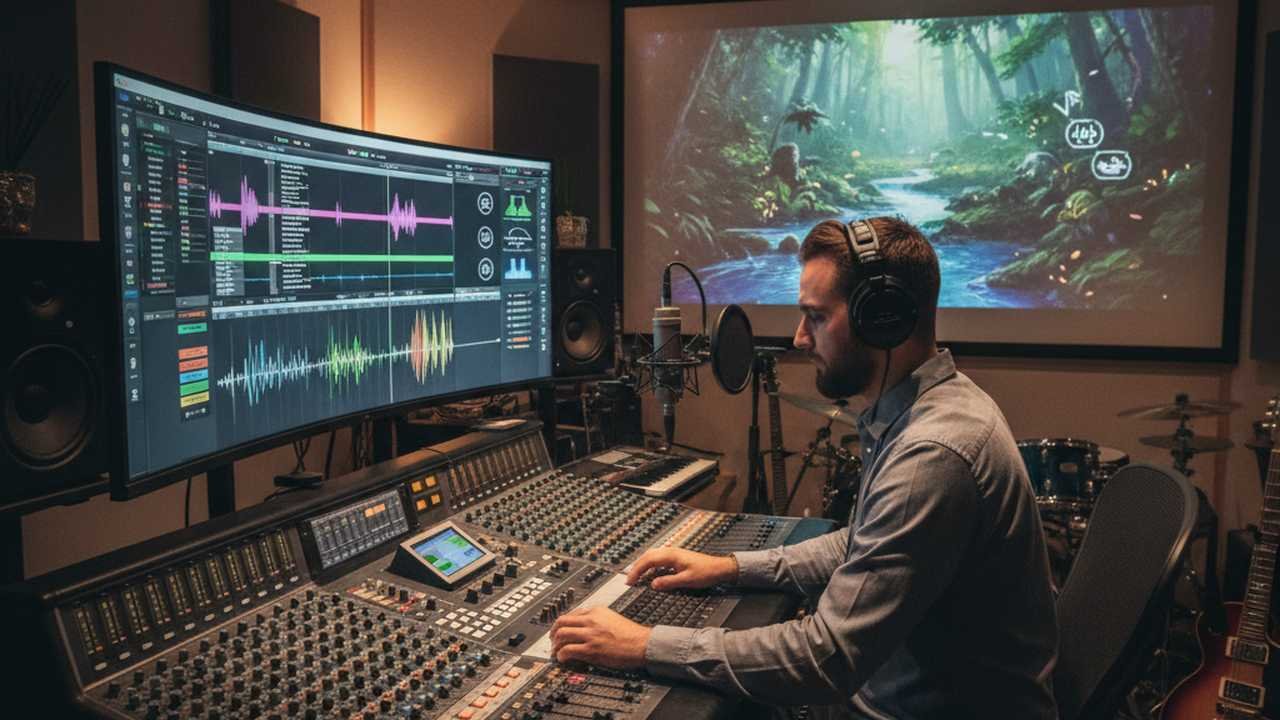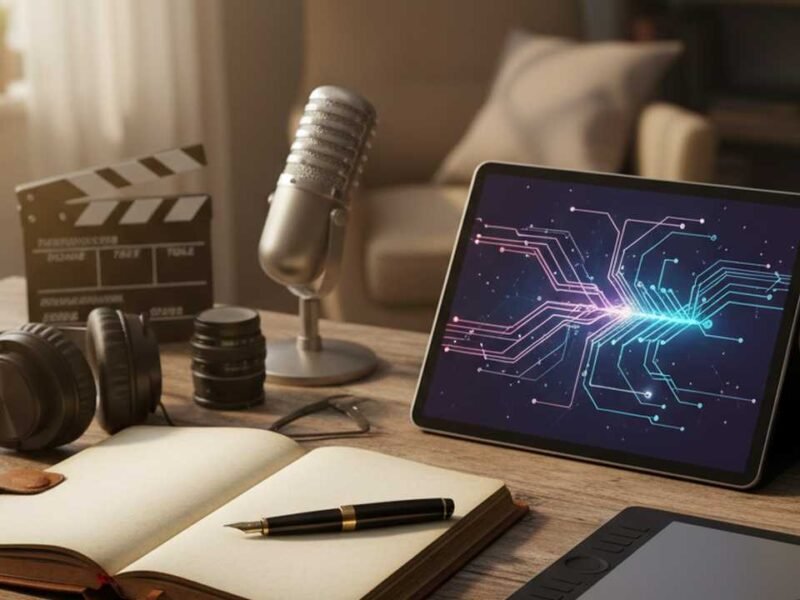In the dynamic realm of multimedia storytelling, sound design emerges as a pivotal force, transforming static visuals into immersive narratives that captivate audiences. Imagine the subtle rustle of leaves in a forest, the distant rumble of thunder, or the poignant silence that follows a climactic moment – these auditory elements do more than accompany visuals; they breathe life into stories, guiding emotions and shaping perceptions. This article delves into the art and science of sound design, exploring its profound impact on storytelling and offering actionable strategies to harness its full potential.
The Power of Sound: Beyond the Visual
Sound is an invisible architect of atmosphere. It crafts the emotional landscape of a story, often conveying what visuals cannot. Consider a suspenseful scene: the gradual crescendo of a heartbeat, the creak of a door opening, the whisper of wind – all these sounds build tension, heighten anticipation, and immerse the audience in the narrative’s emotional core. Without sound, even the most visually stunning scenes can feel hollow, lacking the depth and resonance that make stories memorable. By thoughtfully integrating sound, storytellers can evoke specific emotions, guide audience reactions, and create a more engaging and authentic experience. The strategic use of sound design, therefore, becomes not just an enhancement but a necessity in compelling multimedia storytelling.
Crafting Atmosphere: The Role of Ambient Sound
Ambient sound serves as the sonic backdrop of a story, establishing the setting and grounding the audience in the narrative’s world. Whether it’s the bustling noises of a city street, the serene sounds of nature, or the eerie quiet of an abandoned building, ambient sounds provide context and authenticity. They transport the audience to the story’s location, making the environment feel tangible and real. For instance, the gentle hum of a busy café can evoke a sense of normalcy and comfort, while the distant howl of wolves can instill a sense of danger and isolation. By carefully selecting and layering ambient sounds, creators can enrich their storytelling, adding layers of meaning and enhancing the audience’s immersion in the narrative.
Emotional Resonance: Using Sound to Evoke Feelings
Sound has a unique ability to tap into the emotional undercurrents of a story. The choice of music, the tone of a character’s voice, and the timing of sound effects can all influence how an audience feels at any given moment. A soaring orchestral score can elevate a triumphant scene, while a minimalist piano piece can underscore a moment of introspection. Similarly, the abrupt silence before a sudden sound can create shock and surprise. By aligning sound elements with the emotional trajectory of the story, creators can enhance the audience’s emotional engagement, making the narrative more impactful and memorable. The strategic use of sound, therefore, becomes a powerful tool in shaping the emotional landscape of a story.
Character Voice and Identity: The Significance of Dialogue
Dialogue is a fundamental component of storytelling, providing insight into characters’ thoughts, motivations, and relationships. However, the way dialogue is delivered – its tone, pace, and clarity – can significantly affect how it is perceived. A character’s voice can convey authority, vulnerability, warmth, or coldness, influencing the audience’s connection to them. Moreover, the use of silence or pauses in dialogue can add weight to words, allowing moments to resonate more deeply. By paying attention to the nuances of character voices and dialogue delivery, creators can enrich their characters’ identities and enhance the storytelling experience. The auditory portrayal of characters, therefore, plays a crucial role in audience engagement and narrative depth.
Sound Effects: Enhancing Action and Impact
Sound effects are the dynamic elements that bring action to life. From the clash of swords in a battle to the subtle click of a button, sound effects add realism and excitement to scenes. They punctuate actions, highlight important moments, and guide the audience’s focus. The timing and quality of sound effects can amplify the impact of a scene, making it more thrilling, dramatic, or poignant. For example, the sudden screech of tires can heighten the tension in a car chase, while the soft plink of a falling object can add a touch of whimsy to a comedic moment. By thoughtfully integrating sound effects, creators can enhance the narrative’s energy and ensure that key moments leave a lasting impression.
Peer Educators: Amplifying Voices Through Sound
In the realm of education, peer educators play a vital role in facilitating learning and fostering community. Their experiences and perspectives can offer unique insights, making learning more relatable and accessible. Sound design can amplify the voices of peer educators, ensuring their messages resonate with their audience. By recording and editing their sessions, adding background music, and highlighting key points with sound effects, educators can create engaging and impactful learning materials. This approach not only enhances the educational experience but also empowers peer educators, giving them a platform to share their knowledge and experiences in a compelling way. The integration of sound design in educational content, therefore, serves as a powerful tool in amplifying voices and enhancing learning outcomes.
Interactive Soundscapes: Engaging the Audience
Interactive soundscapes invite the audience to become active participants in the storytelling process. By allowing users to influence or interact with the sound environment, creators can deepen engagement and personalize the experience. For example, in a video game, players might adjust the volume of background music or choose different soundtracks for various levels, tailoring the auditory experience to their preferences. Similarly, in interactive documentaries or virtual reality experiences, users might navigate through different sound environments, uncovering layers of the story through their interactions. These interactive elements not only enhance immersion but also empower the audience, giving them agency in how they experience the narrative. The incorporation of interactive soundscapes, therefore, transforms passive viewers into active participants, enriching the storytelling experience.
Technical Mastery: Tools and Techniques for Effective Sound Design
Achieving high-quality sound design requires both artistic vision and technical expertise. A variety of tools and techniques are available to sound designers, each offering unique capabilities to shape and manipulate sound. Digital Audio Workstations (DAWs) like Pro Tools, Ableton Live, and Logic Pro provide platforms for recording, editing, and mixing audio. Sound libraries offer a vast array of pre-recorded sounds, from everyday noises to specialized effects, which can be incorporated into projects. Additionally, techniques such as Foley – creating custom sound effects by recording real-world actions – allow for greater control and authenticity. Mastery of these tools and techniques enables sound designers to craft soundscapes that enhance storytelling, ensuring that audio elements are seamlessly integrated and contribute meaningfully to the narrative. Technical proficiency, therefore, is essential in realizing the full potential of sound design in multimedia storytelling.
Future Trends: The Evolution of Sound Design in Storytelling
The field of sound design is continually evolving, driven by advancements in technology and changes in audience expectations. Emerging technologies like spatial audio, binaural recording, and artificial intelligence are expanding the possibilities of sound design, allowing for more immersive and personalized experiences. Spatial audio, for instance, enables sounds to be placed in a three-dimensional space, creating a more realistic and enveloping sound environment. Binaural recording captures sound in a way that mimics human hearing, enhancing the sense of presence and immersion. Artificial intelligence is being used to generate adaptive soundscapes that respond in real-time to user interactions. As these technologies develop, they will open new avenues for storytelling, offering creators innovative tools to engage their audiences. Staying abreast of these trends and incorporating them into sound design practices will be crucial for storytellers aiming to remain at the forefront of the industry.


